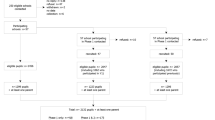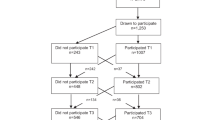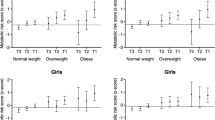Abstract
Background/Objectives
Childhood obesity rates have increased in recent years. The effectiveness of future public health interventions to reduce childhood obesity will be enhanced by a better understanding of behavioral factors that influence adiposity in children as they transition from childhood to adolescence. The purpose of this study was to examine whether initial weight status modifies the longitudinal associations of physical activity, sedentary behavior, and diet quality with changes in adiposity over time.
Subjects/Methods
A total of 658 children (45% boys) were stratified into 3 groups based on 5th grade BMI percentiles ( < 85th, 85–95th, > 95th) and followed from 5th grade to 6th and/or 7th grade. Study variables, including fat-mass-index (FMI), moderate-to-vigorous physical activity (MVPA), diet quality, and sedentary behavior, were measured at 5th, 6th, and/or 7th grades. Separate growth curve models were conducted within each weight status group to examine the associations between MVPA, sedentary behavior, diet quality and adiposity, operationalized as FMI. All models controlled for sex, maturity offset, race, and parent education.
Results
Of the 658 children, 53% were classified with normal weight at baseline, 18% with overweight, and 29% with obesity. Associations between MVPA, sedentary behavior, diet quality and FMI varied within each weight status group. MVPA was negatively associated with adiposity (FMI) for all weight status groups. Diet quality and sedentary behavior were associated with adiposity only in children with obesity at baseline; neither diet quality nor sedentary behavior was associated with FMI for those with overweight.
Conclusions
MVPA was negatively associated with adiposity (FMI) in all weight status groups, suggesting that MVPA may protect against higher adiposity. Sedentary behavior and diet quality were associated with adiposity only in children with obesity at baseline; neither sedentary behavior nor diet quality was associated with FMI for children with overweight.
This is a preview of subscription content, access via your institution
Access options
Subscribe to this journal
Receive 12 print issues and online access
$259.00 per year
only $21.58 per issue
Buy this article
- Purchase on Springer Link
- Instant access to full article PDF
Prices may be subject to local taxes which are calculated during checkout


Similar content being viewed by others
Data availability
The data may be made available on reasonable request from the corresponding author.
References
Fryar CD, Carroll MD, Afful J Prevalence of overweight, obesity, and severe obesity among children and adolescents aged 2–19 years: United States 1963–1965 through 2017–2018. NCHS Health E-Stats 2020.
Centers for Disease Control and Prevention. Recommended community strategies and measurements to prevent obesity in the U.S. MMWR Morb Mortal Wkly Rep. 2009;58:1–26.
Institute of Medicine. Early Childhood Obesity Prevention Policies. Washington, DC: The National Academies Press; 2011.
Institute of Medicine. Accelerating Progress in Obesity Prevention: Solving the Weight of the Nation. Washington, DC: The National Academies Press; 2012.
Centers for Disease Control and Prevention. Strategies to Prevent Obesity and Other Chronic Diseases: The CDC Guide to Strategies to Increase Physical Activity in the Community. Atlanta: US DHHS; 2011.
Centers for Disease Control and Prevention. Strategies to Prevent Obesity and Other Chronic Diseases: The CDC Guide to Strategies to Increase the Consumption of Fruits and Vegetables. Atlanta: US DHHS; 2011.
Bleich SN, Segal J, Wu Y, Wilson R, Wang Y. Systematic review of community-based childhood obesity prevention studies. Pediatrics. 2013;132:e201–10.
Bleich SN, Vercammen KA, Zatz LY, Frelier JM, Ebbeling CB, Peeters A. Interventions to prevent global childhood overweight and obesity: a systematic review. Lancet Diabetes Endocrinol. 2018;6:332–46.
A Hamid MS, Sazlina SG. Interventions for obesity among schoolchildren: A systematic review and meta-analyses. PloS ONE. 2019;14:e0209746.
Must A, Tybor DJ. Physical activity and sedentary behavior: A review of longitudinal studies of weight and adiposity in youth. Int J Obes (Lond). 2005;29:S84–S96.
Fulton JE, Dai S, Steffen LM, Grunbaum JA, Shah SM, Labarthe DR. Physical activity, energy intake, sedentary behavior, and adiposity in youth. Am J Prev Med. 2009;37:S40–9.
Kwon S, Burns TL, Levy SM, Janz KF. Which Contributes More to Childhood Adiposity-High Levels of Sedentarism or Low Levels of Moderate-through-Vigorous Physical Activity? The Iowa Bone Development Study. J Pediatr. 2013;162:1169–74.
Fisher A, Hill C, Webber L, Purslow L, Wardle J. MVPA Is Associated with Lower Weight Gain in 8-10 Year Old Children: A Prospective Study with 1 Year Follow-Up. PLoS ONE. 2011;6:e18576.
Dowda M, Taverno Ross SE, McIver KL, Dishman RK, Pate RR. Physical Activity and Changes in Adiposity in the Transition from Elementary to Middle School. Child Obes. 2017;13:53–62.
Lioret S, McNaughton SA, Cameron AJ, Crawford D, Campbell KJ, Cleland VJ, et al. Three-year change in diet quality and associated changes in BMI among schoolchildren living in socio-economically disadvantaged neighbourhoods. Br J Nutr. 2014;112:260–8.
Jennings A, Welch A, van Sluijs EM, Griffin SJ, Cassidy A. Diet quality is independently associated with weight status in children aged 9-10 years. J Nutr. 2011;141:453–9.
Jago R, Salway R, Emm-Collison L, Sebire SJ, Thompson JL, Lawlor DA. Association of BMI category with change in children’s physical activity between ages 6 and 11 years: A longitudinal study. Int J Obes. 2020;44:104–13.
Mitchell JA, Pate RR, Beets MW, Nader PR. Time spent in sedentary behavior and changes in childhood BMI: a longitudinal study from ages 9 to 15 years. Int J Obes (Lond). 2013;37:54–60.
Corder K, Sharp SJ, Atkin AJ, Griffin SJ, Jones AP, Ekelund U, et al. Change in objectively measured physical activity during the transition to adolescence. Br J Sports Med. 2015;49:730–6.
Nader PR, O’Brien M, Houts R, Bradley R, Belsky J, Crosnoe R, et al. Identifying risk for obesity in early childhood. Pediatrics. 2006;118:e594–e601.
Franckle R, Adler R, Davison K. Accelerated weight gain among children during summer versus school year and related racial/ethnic disparities: A systematic review. Prev Chronic Dis. 2014;11:E101.
Page A, Cooper AR, Stamatakis E, Foster LJ, Crowne EC, Sabin M, et al. Physical activity patterns in nonobese and obese children assessed using minute-by-minute accelerometry. Int J Obes (Lond). 2005;29:1070–6.
Decelis A, Jago R, Fox KR. Objectively assessed physical activity and weight status in Maltese 11–12 year-olds. European Journal of Sport Science. 2014;14:S257–S66.
Cooper AR, Goodman A, Page AS, Sherar LB, Esliger DW, van Sluijs EM, et al. Objectively measured physical activity and sedentary time in youth: the International children’s accelerometry database (ICAD). Int J Behav Nutr Phys Act. 2015;12:113.
Söğüt M, Clemente FM, Clark CCT, Nikolaidis PT, Rosemann T, Knechtle B. Variations in Central Adiposity, Cardiovascular Fitness, and Objectively Measured Physical Activity According to Weight Status in Children (9–11 Years). Front Physiol. 2019;10:936.
Bejarano G, Brayton RP, Ranjit N, Hoelscher DM, Brown D, Knell G. Weight status and meeting the physical activity, sleep, and screen-time guidelines among Texas children: results from a population based, cross-sectional analysis. BMC Pediatrics. 2022;22:428.
Pate RR, Dowda M, Dishman RK, Colabianchi N, Saunders RP, McIver KL. Change in children’s physical activity: Predictors in the transition from elementary to middle school. Am J Preventive Med. 2019;56:e65–e73.
Weber DR, Moore RH, Leonard MB, Zemel BS. Fat and lean BMI reference curves in children and adolescents and their utility in identifying excess adiposity compared with BMI and percentage body fat. Am J Clin Nutr. 2013;98:49–56.
Horlick M, Arpadi SM, Bethel J, Wang J, Moye J Jr, Cuff P, et al. Bioelectrical impedance analysis models for prediction of total body water and fat-free mass in healthy and HIV-infected children and adolescents. Am J Clin Nutr. 2002;76:991–9.
Freedson P, Pober D, Janz KF. Calibration of accelerometer output for children. Med Sci Sports Exerc. 2005;37:S523–S30.
Hunsberger M, O’Malley J, Block T, Norris JC. Relative validation of Block Kids Food Screener for dietary assessment in children and adolescents. Matern Child Nutr. 2015;11:260–70.
Guenther PM, Casavale KO, Reedy J, Kirkpatrick SI, Hiza HAB, Kuczynski KJ, et al. Update of the Healthy Eating Index: HEI-2010. Journal of the Academy of Nutrition and Dietetics. 2013;113:569–80.
Willett W Nutritional Epidemilogy. 2nd ed. New York: Oxford University Press; 1998.
Mirwald RL, Baxter-Jones AG, Bailey DA, Beunen GP. An assessment of maturity from anthropometric measurements. Med Sci Sports Exerc. 2002;34:689–94.
Malina RM, Koziel SM. Validation of maturity offset in a longitudinal sample of Polish boys. J Sports Sci. 2014;32:424–37.
Kuczmarski RJ, Ogden CL, Grummer-Strawn LM, Flegal KM, Guo SS, Wei R. et al. CDC Growth Charts: United States. Adv Data. 2000;314:1–27.
Singer JD, Willett JB Applied Longitudinal Data Analysis. Modeling Change and Event Occurrence. New York: Oxford University Press; 2003.
Schwarzfischer P, Gruszfeld D, Socha P, Luque V, Closa-Monasterolo R, Rousseaux D, et al. Longitudinal analysis of physical activity, sedentary behaviour and anthropometric measures from ages 6 to 11 years. Int J Behav Nutr Phys Activity. 2018;15:126.
Kelley GA, Kelley KS, Pate RR. How Many US Children and Adolescents with Overweight and Obesity Could Improve Their Percent Body Fat by Exercising?: Meta-Analytic Based Estimates. Childhood Obes. 2021;17:144–50.
Kelley GA, Kelley KS, Pate RR. Exercise and adiposity in overweight and obese children and adolescents: a systematic review with network meta-analysis of randomised trials. BMJ Open. 2019;9:e031220.
Pate RR, O’Neill JR, Liese AD, Janz KF, Granberg EM, Colabianchi N, et al. Factors associated with development of excessive fatness in children and adolescents: A review of prospective studies. Obes Rev. 2013;14:645–58.
Janssen X, Basterfield L, Parkinson KN, Pearce MS, Reilly JK, Asamson AJ, et al. Non-linear longitudinal associations between moderate-to-vigorous physical activity and adiposity across the adiposity distribution during childhood and adolescence: Gateshead Millennium Study. Int J Obes. 2019;43:744–50.
Perry CP, Keane E, Layte R, Fitzgerald AP, Perry IJ, Harrington JM. The use of a dietary quality score as a predictor of childhood overweight and obesity. BMC Public Health. 2015;15:581.
Aeberli I, Kaspar M, Zimmerman MB. Dietary intake and physical activity of normal weight and overweight 6- to 14-year-old Swiss children. Swiss Medical Wkly. 2007;137:424–30.
U.S. Department of Health and Human Services. Physical Activity Guidelines for Americans, Second Edition2018. Available from: https://health.gov/paguidelines/second-edition/.
Bull FC, Al-Ansari SS, Biddle S, Borodulin K, Buman MP, Cardon G, et al. World Health Organization 2020 guidelines on physical activity and sedentary behaviour. Br J Sports Med. 2020;54:1451–62.
Department of Health. Australia’s Physical Activity and Sedentary Behaviour Guidelines. Canberra; 2019.
Tremblay MS, Carson V, Chaput JP, Connor Gorber S, Dinh T, Duggan M, et al. Canadian 24-Hour Movement Guidelines for Children and Youth: An Integration of Physical Activity, Sedentary Behaviour, and Sleep. Appl Physiol Nutr Metab. 2016;41:S311–27.
Acknowledgements
The authors thank Gaye Groover Christmus, MPH for editorial assistance in the preparation of the manuscript. This study was funded by grant number RO1HL091002 from the National Heart, Lung, and Blood Institute.
Author information
Authors and Affiliations
Contributions
RP, RS, and RD were responsible for designing the study. MD managed the data and performed analysis and original manuscript drafting. RP, RS, and RD were involved in writing, review, and editing.
Corresponding author
Ethics declarations
Competing interests
The authors declare no competing interests.
Additional information
Publisher’s note Springer Nature remains neutral with regard to jurisdictional claims in published maps and institutional affiliations.
Rights and permissions
Springer Nature or its licensor (e.g. a society or other partner) holds exclusive rights to this article under a publishing agreement with the author(s) or other rightsholder(s); author self-archiving of the accepted manuscript version of this article is solely governed by the terms of such publishing agreement and applicable law.
About this article
Cite this article
Dowda, M., Saunders, R.P., Dishman, R.K. et al. Association of physical activity, sedentary behavior, diet quality with adiposity: a longitudinal analysis in children categorized by baseline weight status. Int J Obes 48, 240–246 (2024). https://doi.org/10.1038/s41366-023-01405-2
Received:
Revised:
Accepted:
Published:
Issue Date:
DOI: https://doi.org/10.1038/s41366-023-01405-2



